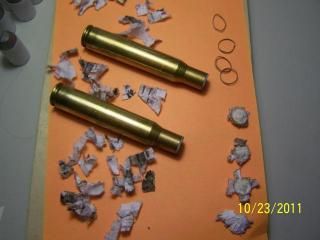Concerning reloading technique's. In the past I always trimmed my brass to its Minimum specs. As we all know doing so eliminates the Seater dies re-adjustment case to case or batch to batch of brass (so long as the same boolit/s are used.)
Now I'm not so sure if that is the correct thing to do since a patched boolit is held primarily by its cartridges neck without any deliberate crimp applied. {so~~~ any and all (shaved brass) kept intact on a patching cartridge's neck helps for a better held in place papered boolit.} So~~ this is where a cartridge case needs to be filled to its capacity i.e. too assuredly stop that rearward boolits movement upon recoil. I'll assume such thinking is correct unless told differently.
So here's my question.
I can imagine a shortened to spec brass having far less boolit holding abilities and over time even a filled full cartridge will settle its powder some over time which no doubt allow its un-crimped boolit to move rearward at recoil. Allowing some/perhaps lots of movement to take place inaccuracy is sure to take place. So what can one do to keep those patched boolits permanently in place other than their crimping? (can't just super glue them lead patched pills in place)
Frankly: I'm not found of using manufactured glue in any form or mixture in my barrel/s. I'm looking for a Tip or Trick for my application of paper patching.
Thanks for any & all input.

|
   
   
|


|




 Reply With Quote
Reply With Quote












